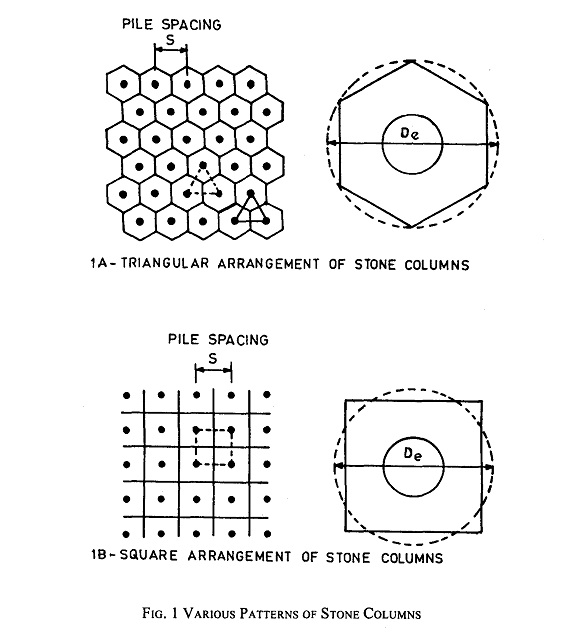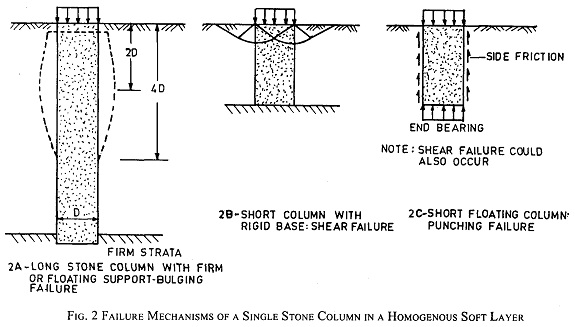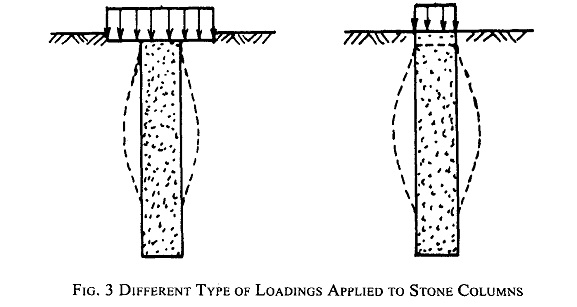





Published on Nov 30, 2023
Ground improvement techniques are commonly used at sites where the existing soil conditions are expected to lead to unsatisfactory performance. Soil improvement techniques are employed to increase the strength and stiffness of soil deposits.
Current soil improvement techniques can be divided into four broad categories:-
1. Densification techniques.
2 Drainage techniques
3. Grouting techniques.
4. Reinforcement techniques.
Densification techniques include:
- Dynamic compaction
- Vibro techniques
- Compaction grouting
- Blasting
Dynamic- compaction, vibro- techniques and blasting are used for loose granular soils. Compaction grouting is a technique in which grout is pumped at high pressures.
Drainage is done to minimize the build up porewater pressure during earthquakes by shortening the drainage path in a soil deposit. The installation of drains involves some degree of densification and drains themselves may also provide some reinforcement. Unacceptable movements of slopes, embankments, retaining structures and foundation can be eluminated by lowering ground water table prior to earthquake.
a. Permeation grouting: involves injection of low viscosity liquid grout (fly ash, bentonite…) into soil without disturbing soil structure.
b. Intrusion grouting: involves injection of fluid grout under pressure to cause controlled fracturing of soil.
c. Soil mixing: cementations material is mechanically mixed into the soil using a hollow stem auger and paddle arrangement.
d. Jet grouting: cement grout is injected horizontally under high pressure in a previously drilled hole.
Introduction of discrete inclusions(steel,concrete,timber,geomaterial such as densified gravel) to strengthen and stiffen the soil deposit. The high stiffness and strength of inclusions also tend to reduce the stresses imposed on the weaker material between the inclusions.
Stone columns have been used as a technique for improving both cohesive soils and silty sands to increase strength and decrease compressibility. Stone columns can improve a soil deposit by densification, reinforcement and drainage functions.
Out of several techniques available for improving soft clay stone columns are ideally suited for structures with wide spread loads. In case of soil having medium to low safe bearing capacity ground improvement with the help of stone columns have been found economical and faster in construction. The main aim of soil improvement is to increase the shear strength ,loading capacity ,stability and settlement control.
Stone column technique also known as vibroreplacement or vibrodisplacement is a ground improvement technique where vertical columns of compacted aggregate are formed through the soil to be improved .
- Stone columns help in improving slopes of both embankments and natural slopes.
- Being granular and free draining, consolidation settlements are accelerated and post compaction settlements are minimized.
-Increase in resistance of soil to liquefaction, reduction of foundation settlements and increase in load carrying capacity.
- Stone columns can also resist lateral load.
- Construction is simple and cost effective.
Stone columns combine at least four different mechanisms for improvement of liquefiable Soil deposits:
i. Stone columns improve the deposit by virtue of their own high density, strength and stiffness.
ii. Stone columns provide closely spaced drainage boundaries that inhibit
the development of high excess pore water pressure.
iii. The process by which stone columns are installed densify the soil surrounding by combined effect of vibration and displacement.
iv. The installation process increases the lateral stress in the soil surrounding the stone columns.
Stone columns in saturated cohesive soils work as drainage system and resulting in decreasing consolidation time. Stone column systems in soft compressible soils are like pile foundation except that pile caps, structural connections and deep penetration to underlying firm strata are not required.
Installation of stone columns in soft cohesive soils is basically a self compensating process that is softer the soil, bigger is the diameter of the stone column formed. Due to lateral displacement of stones during vibrations/ramming, the completed diameter of the hole is always greater than the initial diameter of the probe or the casing depending upon the soil type, its undrained shear strength, stone size, characteristics of the vibrating probe/rammer used and the construction method.
Approximate diameter of the stone column in the field may be determined from the known
compacted volume of material required to fill the hole of known length and maximum and minimum densities of the stone.
Stone columns should be installed preferably in an equilateral triangular pattern which givesthe most dense packing .Although a square pattern may also be used.
The design of stone columns should be site specific and no precise guidelines can be given on the maximum and the minimum column spacing. However, the column spacing may broadly range from 2 to 3 depending upon the site conditions, loading pattern, column factors, the installation technique, settlement tolerances, etc.
For large projects, it is desirable to carry out field trials to determine the most optimum spacing of stone columns taking into consideration the required bearing capacity of the soil and permissible settlement of the foundation.

The tributary area of the soil surrounding each stone column forms regular hexagon around the column. It may be closely approximated by an equivalent circular area having the same total area.
The equivalent circle has an effective diameter (De) which is given by following equation:
D, = 1.05 S for an equilateral pattern, and
D= 1.13 S for a square pattern
Where S = spacing of the stone columns.
Load capacity of the treated ground may be obtained by summing up the contribution of each of the following components for wide spread loads, such as tanks and embankments:
i.Capacity of the stone column resulting from the resistance offered by the surrounding soil against its lateral deformation (bulging) under axial load.(Q1)
ii.Capacity of the stone column resulting from increase in resistance offered by the surrounding soil due to surcharge over it.(Q2)
iii.Bearing support provided by the intervening soil between the columns.(Q3)
The foundation soil is at failure when stressed horizontally due to bulging of stone column.
Initially, the surcharge load is supported entirely by the rigid column. As the column dilates some load is shared by the intervening soil depending upon the relative rigidity of the column and the soil. Consolidation of soil under this load results in an increase in its strength which provides additional lateral resistance against bulging.
The surcharge load may consist of sand blanket and sand pad (being applicable to tank foundations). If thicknesses of these elements are not known, the limiting thickness of the surcharge loading as represented by the safe bearing capacity of the soil may be considered. The increase in capacity of the column due to surcharge may be computed in terms of increase in mean radial stress of the soil.
The surcharge effect is minimum at edges and it should be compensated by installing additional columns in the peripheral region of the facility.
This component consists of the intrinsic capacity of the virgin soil to support a vertical load which maybe computed as follows:
Effective area of stone column including the intervening soil for triangular pattern = 0.866 s*s.
Area of intervening soil for each column, Ag is given by the following formula:
Ag = 0.866 S²-(π*D²/4)
Safe load taken by the intervening soil, Q3 = q(safe)*Ag
Overall safe load on each column= Q1+Q2+Q3.
Design calculations should be repeated till there is convergence of the assumed and the calculated column spacing. One or two trials may be required to achieve an acceptable degree of convergence.
Additional stone columns may be required inside and outside the periphery of the loaded area considering pressure distribution, presence/absence of surcharge and permissible or expected settlement of the structure. These additional columns may be provided either as rings or at a closer spacing for an appropriate distance inside as well as outside the periphery of the loaded area.
Failure mechanism of a single stone column in a homogeneous soils loaded over its area significantly depends upon the length of the column. For columns having length greater than its critical length (that is about 4 times the column diameter) and irrespective whether it is end bearing or floating, it fails by bulging (Fig). However, column shorter than the critical length are likely to fail in general shear if it is end bearing on a rigid base (Fig) and in end bearing if it is a floating column as shown in Fig.
Whenever, a stone column is usually loaded over an area greater than its own (see Fig) in which case it experiences significantly less bulging leading to greater ultimate load capacity and reduced settlements since the load is carried by both the stone column and the surrounding soil.


Wherever interlayering of sand and clay occurs, effective reduction in settlement may be brought about by carrying out the treatment of stone columns through the compressible layer. When clay is present in the form of lenses and if the ratio of the thickness of the lenses to the stone column diameter is less than or equal to 1, the settlement due to presence of lenses may be insignificant. In mixed soils, the failure of stone columns should be checked both for predominantly sandy soils as well as the clayey soil, the governing value being lower of the two calculated values.
a) factors stated influencing installation of stone columns by vibroflot include soil type, initial soil strength, probe spacing and pattern. Spacing and volume for soils containing more than 20 percent fines (less than 0.074 mm size), stone columning maybe adopted for improving the engineering properties of the soil. The soft clays to be treated should have their sensitivity not exceeding 4, preferably 3 and under and undrained shear strength generally not less than 0.7 t/m2.
b) Crushed stone or gravel may be used as backfill material. The individual stones should be chemically inert, hard and resistant to breakage. The size of material should not be too large to cause arching of stones between the vibroflot and the borehole walls thereby preventing the material to reach the tip of the vibrator. Well graded stones of 75 mm to 2mm size may be used. It maybe noted that stones of uniform size may permit penetration of clay into the large sized voids thereby jeopardizing the capacity of the column and/or its function as a vertical drain.
c) Backfill gradation, rate of shoving the backfill material into the hole and the upward water velocity should be carefully controlled during the backfilling operation as they have significant effect on the backfill densities achieved.
- Stone columns help in improving slopes of both embankments and natural slopes.
- Being granular and free draining, consolidation settlements are accelerated and post compaction settlements are minimized.
- -Increase in resistance of soil to liquefaction, reduction of foundation settlements and increase in load carrying capacity.
- Stone columns can also resist lateral load.
- Construction is simple and cost effective.
i. Soil engineering in theory and practice volume-3 by Alam Singh.
ii. Foundation analysis and design by Joseph.E.Bowles.
iii. Foundation design by Nainan.P.Kurian.
iv. IS 15284(part 1)-2003 design and construction for ground improvement- Guidelines (Part 1) - Stone columns.
v. IS 13094-1992 Ground improvement-techniques on weak soil.
| Are you interested in this topic.Then visit the below page to get the full report |